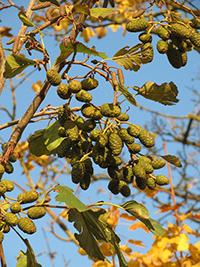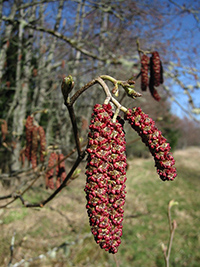Ancient authors did not know the medicinal properties of the black alder tree. Saint Hildegard, a German St. Benedict abbess of the 12th century, was the first to write about these properties. She published two interesting works on medicinal herbs.
When malaria ran rampant between the 18th and 19th centuries, and American-imported quinine was challenging to obtain, black alder bark was used as a febrifuge. It was called European quinine. Today, the black alder tree is still used in phytotherapy and has many other applications as well. Its bark is used for tanning leather, and its sawdust is used to smoke fish and meat.
Black alder wood resists water well and is practically impossible to rot. Some bridges in Venice and London have been built with this wood. Moreover, it is used to make excellent shoes.

Black Alder Tree Scientific Facts
- Scientific name: Alnus glutinosa L.
- Other names: European alder, owler.
- French: Aulne.
- Spanish: Aliso.
- Environment: Common in wet forests all over warm Europe. It also grows wild in some North American regions.
- Description: Deciduous tree of the Betulaceae family, growing up to 20 m high, with an upright trunk, greyish bark, toothed leaves, dark green colored on the upper side, and light green on their underside. This is a monoic tree, an identical plant that houses male and female flowers.
- Parts of the plant used medicinally: The bark of young branches and the leaves.
Healing Properties and Indications

Black alder tree BARK is rich in tannin (up to twenty percent). It also contains a red-coloring substance of a glycoside nature, named emodin, and lipoid substances. Due to its tannin content, it is an excellent astringent that dries the mucosa, whether internally or externally. Moreover, it has febrifuge properties. It is recommended in the following cases:

- Summer diarrhea, gastroenteritis, and colitis.
- Stomatitis (inflammation of the oral mucosa), tonsilitis, and pharyngitis: doing gargles with the liquid of its decoction.
- Varicose ulceration, sores, and difficult-to-heal wounds: A decoction of black alder bark is applied to compress the affected area.
- Fever diseases such as malaria or brucellosis, when decreasing fever, are recommended. In this case, the decoction is taken orally, under medical supervision.
Black alder tree LEAVES contain tannin and sugars, and a glutinous substance covers them, composed of two alcohols (glutinol and glutanol) and their corresponding acids. Their properties are as follows:
- Vulnerary helps cicatrize wounds and heal bruises. It is beneficial when healing aching feet and bruises from long walks or ill-fitting shoes. Put the leaves inside your socks, with their upper side touching the skin. The tired sensation will be alleviated, and the rubs will quickly heal.
- Antirheumatic. Wrap the ill person with black alder leaves previously heated under sunlight or inside an oven, then cover the painful area with a blanket. This “leaf bath” is a good remedy for alleviating rheumatic and arthrosis aches and has perspirant and depurative effects.
- Galactofuge. They produce a decrease in milk production in breastfeeding women. To achieve this effect, put a poultice of leaves on the breasts.
How to use Black Alder
- Decoction, with 30-40 g of young branches bark, boiling for 15 minutes. Drink two or three cups daily.
- The same decoction can be used for gargles, rinses, and compresses.
- Poultices. The leaves are locally applied, such as vulnerary (inside socks with their upper side touching the skin), antirheumatic (covering the painful area after heating in an oven), or galactofuge (on the breasts). Black alder leaves must always be applied when green, primarily when used as a vulnerary.

Red Alder
Red alder is more common in North America (Alnus rubra L.), also called Oregon alder. The red and the common alder species are very close from a botanical point of view and have practically the same properties and applications.
Frequently Asked Question
What parts of the black alder tree are used medicinally?
The chief parts used are the bark and leaves. The bark has a higher concentration of tannins, while leaves may contain additional beneficial compounds.
How does the black alder tree potentially help with sore throats?
Black alder’s astringent properties may come from tannins, which can tighten mucous membranes, soothing a sore throat.
Are there studies on the black alder tree and diarrhea?
While traditionally used for diarrhea, limited scientific evidence supports this use. More research is needed to determine its effectiveness.
Can black alder help with diabetes?
Some animal studies suggest black alder may have blood sugar-lowering properties.
How might black alder benefit skin health?
Black alder’s antibacterial and astringent properties may be useful for wound healing and reducing inflammation.
Are there interactions between black alder and medications?
The plant may interact with blood sugar-lowering medications. If you take medication, consult a healthcare professional before using supplements.
Can pregnant or breastfeeding women take black alder?
There is insufficient information on the safety of black alder for pregnant or breastfeeding women. Avoid using it unless advised by a healthcare professional.
What are the potential side effects of black alder?
It may cause constipation, nausea, or stomach upset in some individuals. Discontinue use if you experience any adverse effects.
Is black alder safe for long-term use?
The long-term safety of black alder is unknown. Consult a healthcare professional for direction on appropriate use.
How should black alder be stored?
Store black alder bark or leaves in a cool, dark place in an airtight container to preserve quality.
DISCLAIMER: All content on this website is presented solely for educational and informational objectives. Do not rely on the information provided as a replacement for advice, diagnosis, or treatment from a qualified medical expert. If you are pregnant, nursing, or have any preexisting medical concerns, talk to your doctor before using any herbal or natural medicines.
REFERENCES
- George D. Pamplona-Roger, M.D. “Encyclopedia of Medicinal Plants.” George D. Pamplona-Roger, M.D. Encyclopedia of Medicinal Plants. Ed. Francesc X. Gelabert. vols. 2 San Fernando de Henares: Editorial Safeliz, 2000. 487, 488. Print. [Black alder tree]
- WebMD: https://www.webmd.com/vitamins/ai/ingredientmono-589/black-alder
- https://www.webmd.com/vitamins/ai/ingredientmono-217/tannic-acid
- https://www.ncbi.nlm.nih.gov/books/NBK448082/
- https://pubmed.ncbi.nlm.nih.gov/31855345/
- https://www.ncbi.nlm.nih.gov/pmc/articles/PMC10535473/
- https://www.webmd.com/vitamins/ai/ingredientmono-589/black-alder
- https://heavenlymountainherbs.com/
